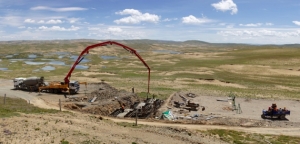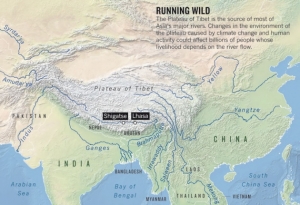Climate Change and Pollution Threat
An assessment was conducted earlier this month, which supplies new data about the rise in climate change effects and pollution in Tibet. According to research, the average temperature has soared by 0.4 Degree Celsius per decade, while precipitation has risen by 12% since 1960.
Tibet’s plateau and its surrounding mountain have the largest pile of ice outside of the Arctic and Antarctica, giving it the nick name “the third pole”. Researchers found that due to the melting of glaciers the region has now 14% more lakes comparing to 1970 and more than 80% of existing lakes have been expanded.

Kieran Dodds/Panos
Hot, dry weather and progressive urbanization are turning grasslands into sand near the headwaters of the Yellow, Yangtze and Mekong rivers.
Tibet also feed Asia’s biggest rivers, which flow to Pakistan, India, Southeast Asia and China, which means extra water could affect billions of people downstream. Amidst the changing climate, Tibet’s population is booming. It is estimated that now the plateau has roughly 9 million people – which is three times the population in 1951. Pollution from human and industrial waste as a result of rapid development is also a serious risk, the report says.
But the assessment also suggests ways to combat the problems, calling on Chinese and Tibetan government to make conservation and environmental protection top priorities. Meng Deli, Tibet’s vice-chairman says, it will help in the design of “policies for mitigating climate change and striking a balance between development and conservation”
“The Tibetan plateau is getting warmer and wetter,” says Yao Tandong, director of the CAS Institute of Tibetan Plateau Research in Beijing, who led the assessment.
Tibet’s biggest pollution change however comes from unchecked and poorly regulated mining activities. The assessment found that Tibetan open pit mines produced 100 million metric tons of waste water in 2007 and nearly 20 million metric tons of solid waste in 2009. As a result air, water and soil pollution is particularly very serious, according to the report.
The Tibetan and Chinese research team hopes its report can influence government policy on conservation and environment protection, Nature noted. The findings can help direct “policies for mitigating climate change and striking a balance between development and conservation” said Meng Deli, vice-chairman of Tibet’s regional government.
“Tibet will be a test case of how seriously China takes ecological protection,” says Yao. “Safeguarding the plateau environment is crucial not only for sustainable development of the region, but also to social stability and international relations.”
Source: www.nature.com/www.ibtimes.com


comment 0